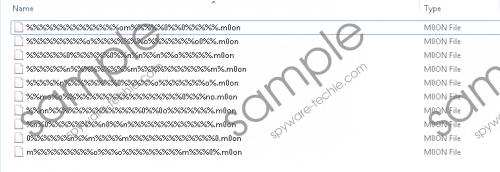Do you know what M0on Ransomware is?
Sometimes it is easier to deal with full-developed malicious programs, rather than applications that are clearly still work-in-progress. M0on Ransomware is an underdeveloped infection that does only half of the things a ransomware program is supposed to do. However, it can surely give you a run for your money, so you should not take this infection lightly. In this description, we will tell you more about the program and how to remove it from your computer. Please take note that you will not be able to operate your computer and access your files if you fail to get rid of this application.
Each ransomware infection has a list of files it can encrypt. These programs usually target particular extensions. For instance, M0on Ransomware can affect files that have mpg, .mrw, .msg, .nef, .nes, .nrw, .odb, .odc, .odm, .odp, .ods, .odt, .orf, .p12, .p7b, .p7c, .pdb, .pdf, .pef, .pem, .pfx, .php, .php, .plb, .pmd, .png, .pot, .potm, .potx, .ppam, .ppj, .pps, .ppsm, .ppsx, .ppt, .pptm, .pptx, .prel, .prproj, .ps, .psd, .pst, .ptx, .qq, .r3d, .ra, .raf, .rar, .raw, .rb, .rcb, .rtf, .rw2, .rwl, .sdf, .sldm, .sldx, .sql, .sr2, .srf, .srw, .svg, .swf, .tif, .txt, and many other different extensions. If you are more familiar for your file system, you will probably notice that most of these extensions are common to files found in the %USERPROFILE% directory.
Our research team says that M0on Ransomware will mostly encrypt files that are in that exact directory and all of its subfolders. So if you happen to have most of your files in some other directory, especially some folder that is not default and more like custom, created by yourself, it is very likely that your files will remain intact. However, if you have cloud storage files mapped in the same directory, it is possible for the ransomware to encrypt your online-stored files too! M0on Ransomware screenshot
M0on Ransomware screenshot
Scroll down for full removal instructions
Since the application is not available out in the open, there is no public decryption tool that would help you restore your files. Of course, if you keep a system backup on an external hard drive, you can always place the healthy copies of your files back into your computer. The most important thing is to remove M0on Ransomware before you copy and paste your files back.
You see, upon the infection, the ransomware creates a registry entry in HKEY_CURRENT_USER\Software\Microsoft\Windows\CurrentVersion\RunOnce. The value name for this new entry is “adr,” and the value data points to a malicious file M0on Ransomware drops in the %TEMP% directory once the infection is launched. Usually, the malicious filename is m0on.exe, but it is also very likely that once the program goes through further development, the filename will be randomized. Either way, when you restart your computer, the registry key added by the infection deletes itself automatically because it is the RunOnce key, but the infection starts all of its processes all over again, creating yet another RunOnce entry. So even if it looks like M0on Ransomware should run only once, the program pulls you into a vicious cycle.
You can get out of this loop by removing M0on Ransomware from the system. Although the main malicious files will be stored in the %TEMP% directory, there might also be another malicious file that launched the installation. You will probably find it in the Downloads folder because this one and other ransomware infections often come through spam emails and other downloadable files.
If you are not sure how to go around it, you can always get yourself a computer security application. In fact, this is what malware experts always recommend: relying on a legitimate security tool is always a lot better than trying to solve problems on your own. It is okay if you are a computer security expert, but if you are just an average computer user, it is very easy to overlook signs and files that could, later on, leave a detrimental effect on your system’s security.
So when you delete M0on Ransomware, please run a full system scan with the SpyHunter free scanner to locate other potential threats. Even if your computer is clean, you should consider keeping a security tool on all the time to prevent similar threats from entering your PC.
How to Remove M0on Ransomware
- Go to your Downloads folder.
- Delete the recently launched malicious file.
- Press Win+R and the Run prompt will open.
- Type %TEMP% into the Open box and click OK.
- Delete the m0on.exe file from the directory.
- Scan your PC with a security tool.
In non-techie terms:
Normally, a malicious infection like M0on Ransomware would demand that you pay a ransom fee to receive a decryption key that would help you get your files back. However, this infection in question is so poorly made that it does not even display such a notice. So your main task right here is to terminate M0on Ransomware for good, at the same restoring the status quo of your system. Should you have any further questions about this program or your computer’s security in general, please do not hesitate to leave us a comment below.
